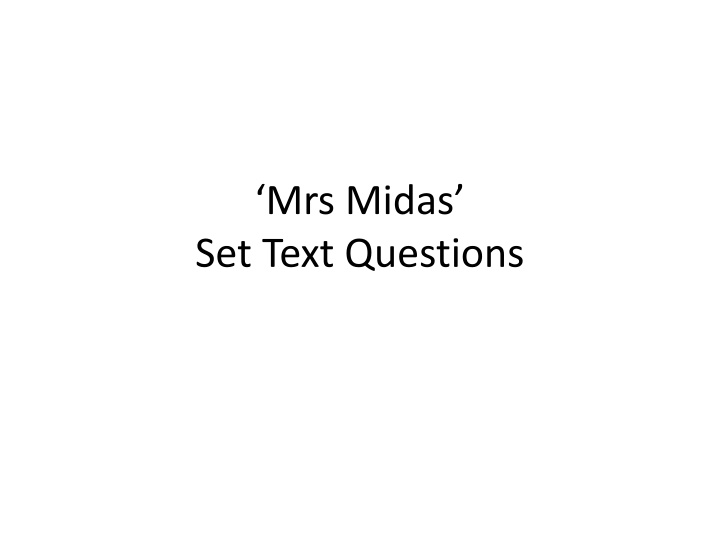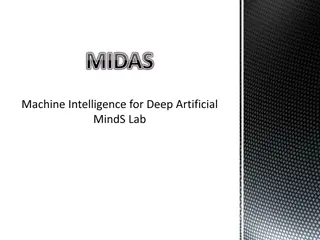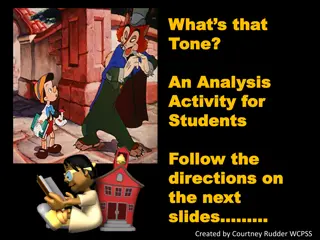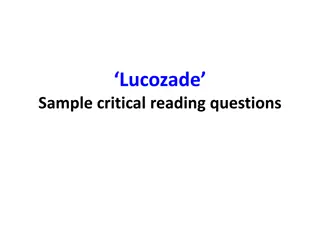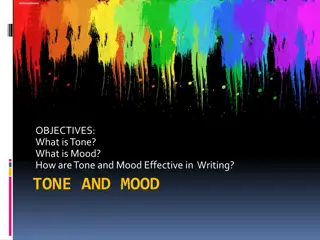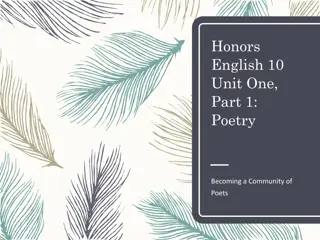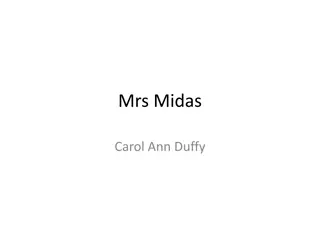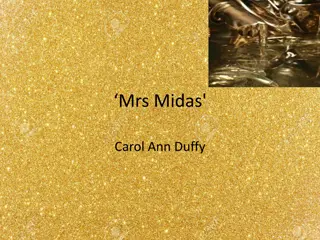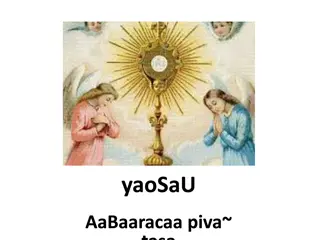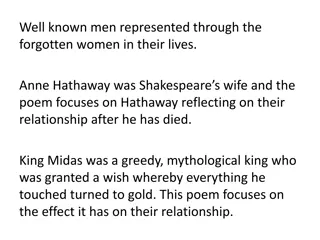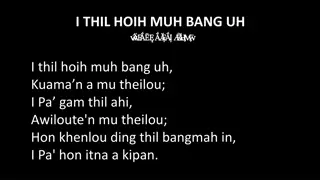Analysis of Poetic Techniques in "Mrs. Midas" Verses for Mood Creation
Late September in "Mrs. Midas", the use of poetic techniques such as personification, contrast in consonant sounds, and building tension through language effectively conveys the relaxed atmosphere changing to chaos. The language choice in building up to the climax adds to the absurdity and horror of the situation, culminating in Mrs. Midas beginning to scream.
Download Presentation

Please find below an Image/Link to download the presentation.
The content on the website is provided AS IS for your information and personal use only. It may not be sold, licensed, or shared on other websites without obtaining consent from the author.If you encounter any issues during the download, it is possible that the publisher has removed the file from their server.
You are allowed to download the files provided on this website for personal or commercial use, subject to the condition that they are used lawfully. All files are the property of their respective owners.
The content on the website is provided AS IS for your information and personal use only. It may not be sold, licensed, or shared on other websites without obtaining consent from the author.
E N D
Presentation Transcript
Mrs Midas Set Text Questions
It was late September. I'd just poured a glass of wine, begun to unwind, while the vegetables cooked. The kitchen filled with the smell of itself, relaxed, its steamy breath gently blanching the windows. So I opened one, then with my fingers wiped the other's glass like a brow. He was standing under the pear tree snapping a twig. 1. Referring to at least two examples, analyse the use of poetic techniques to create mood in verse 1. (2) The mood is relaxed, reflected by the language used to describe the scene : unwinds , relaxed , gently blanching the windows (1) its steamy breath / gently blanching the windows - the personification of the kitchen creates a warm, appealing, atmosphere. (1) The atmosphere is shattered by the final line: snapping a twig. this connotes something violent. The harsh consonant sounds in the final phrase contrast with softer consonant and vowel sounds earlier in the stanza. (1)
I served up the meal. For starters, corn on the cob. Within seconds he was spitting out the teeth of the rich. He toyed with his spoon, then mine, then with the knives, the forks. He asked where was the wine. I poured with shaking hand, a fragrant, bone-dry white from Italy, then watched as he picked up the glass, goblet, golden chalice, drank. It was then that I started to scream. 2. In what ways is the language of verse 4 effective in building up to the climax It was then that I started to scream ? (4) I served up the meal The stanza starts with a comic effect Mrs Midas continues to go about her domestic chores despite the absurd situation. (1) corn on the cob spitting out the teeth of the rich This is an appropriate choice of food and visually fitting. The horror of what is happening becomes apparent Midas can t even eat. This represents the fact that his greed and desire for wealth has brought him to this. (1)
I served up the meal. For starters, corn on the cob. Within seconds he was spitting out the teeth of the rich. He toyed with his spoon, then mine, then with the knives, the forks. He asked where was the wine. I poured with shaking hand, a fragrant, bone-dry white from Italy, then watched as he picked up the glass, goblet, golden chalice, drank. It was then that I started to scream. 2. In what ways is the language of verse 4 effective in building up to the climax It was then that I started to scream ? (4) his spoon, then mine, then with the knives, the forks. Use of a list, one thing after another, reflects Mrs Midas growing realisation of the impact of her husband s gift (1) shaking further emphasises Mrs M s anxiety over what is happening. (1)
I served up the meal. For starters, corn on the cob. Within seconds he was spitting out the teeth of the rich. He toyed with his spoon, then mine, then with the knives, the forks. He asked where was the wine. I poured with shaking hand, a fragrant, bone-dry white from Italy, then watched as he picked up the glass, goblet, golden chalice, drank. It was then that I started to scream. 2. In what ways is the language of verse 4 effective in building up to the climax It was then that I started to scream ? (4) picked up the glass, goblet, golden chalice, drank. The alliteration and harsh consonant sounds add to the drama and seriousness of the situation. chalice is often associated with the last supper, with connotations of death. (1) These phrases build up to a sense of panic at the start of the next stanza as Mrs Midas accepts the full reality of what has happened. Scream demonstrates her horror. (1)
3. Identify and analyse aspects of the language or structure in this extract which create a believable narrative voice for the persona. (4) The six-line unrhymed stanzas of irregular line length means that it reads almost like prose with plenty of run-on lines and not much evidence of rhythm in the diction this makes it sound like someone talking to us. Each line has approximately 12 15 syllables which creates a relaxed, narrative effect. Use of third person to speak directly to the reader in line 14: He drew the blinds. You know the mind; I thought of This makes it sound as if the narrator is speaking directly to us.
3. Identify and analyse aspects of the language or structure in this extract which create a believable narrative voice for the persona. (4) A conversational feel is created with asides and interjections (interruptions) of added or qualifying information: And then he plucked a pear from a branch - we grew Fondante d'Automne - This creates an intimacy between the speaker and listener. The conversational tone means that, since we notice the story we almost forget how horrific and weird the events are. I thought to myself, Is he putting fairy lights in the tree? The one word sentence adds dramatic effect and the question in the last line again highlights Mrs Midas s shock and disbelief, making her seem more realistic. and it sat in his palm like a light bulb. On.
4. By referring to this poem and at least one other by Carol Ann Duffy, show how effectively she explores the joys and sorrows of a close relationship. (8 / 10)
Answering the final set text question By referring to this poem and at least one other by Carol Ann Duffy, show how effectively she explores the joys and sorrows of a close relationship. (8 / 10) 1. Refer to another text(s) and say what it has in common / in contrast with the given text. (2) 2. Refer to the extract you have been given in relation to the question. (2) 3. Refer to another text(s) in relation to the question. (1 x relevant reference to technique / idea / feature (1) + 1 x appropriate comment (1)) 4. Repeat step 3. (2) 5. Repeat step 3 again for H. (2)
